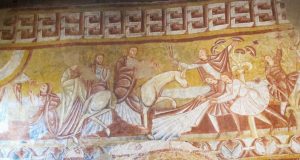There is an old saying: If you want to hide something, put it in plain sight. To our surprise, we learned that this saying is especially true for Christianity, where medieval works of art were created to illustrate the teachings of the Bible for the largely illiterate population. A close look at these religious works of art reveals the presence of psychedelic plants–hidden in plain sight for centuries.
Based on stunning visual evidence found in cathedrals and churches, we invite you to join us as we visit “Five Sacred Psychedelic Sites” and relive our discovery of the “Psychedelic Gospels” ̶ an alternative history of Christianity.
1/ Christ’s Entry to Jerusalem, St. Martin de Vicq, France

The church of Saint Martin de Vicq sits unpretentiously in a village in central France. Although the exterior of the church is drab, stepping into the church is like having cataracts removed from your eyes and suddenly seeing again in vibrant color. Once inside the resplendent choir, Julie and I were enchanted by a majestic visual feast of frescoes on the walls, guarded by rosy-cheeked angels.
As we were contemplating this illustrated Bible, Julie took my arm and turned me around to look at the wall-length panel of Christ’s Entry into Jerusalem. “Do you see what I see?” she asked. There was no way I could miss the five psilocybin mushrooms, whose smooth tan caps gracefully spread out over the heads of the joyful youth welcoming Jesus to Jerusalem for his messianic date with destiny.
As the late afternoon sunlight filled the choir, we felt as if the frescoes were coming alive, were speaking to us. It was then that Julie and I had our “aha” moment: these frescoes were revealing an alternative history of Christianity ̶ a Psychedelic Gospels.
But, wait a minute, what if these mushroom icons were simply the eccentric creations of an heretical Christian cult, of some medieval “hippie priests,” living deep in the forest, far from the reach of church and crown? To answer these questions, we decided to visit the High Holy Sites of Christendom.
2/ Conversion of St. Eustace, Chartres Cathedral, France

As Julie and I entered Chartres Cathedral, located southwest of Paris, we were swept away, suddenly moving within a kaleidoscope symphony of glass and light. Each step we took flooded our senses with multicolored lights, which came streaming through the elegant stained-glass windows that soared more than one hundred feet above the cathedral floor. To our surprise, we found that nearly ten percent of the 176 stained-glass windows, each of which tells a bible story (the life of Mary, the Last Judgement), contained distinct mushroom images.
For example, in the New Testament story of Saint Eustace, the opening panel shows Placidas (the future St. Eustace) hunting stag on horseback. In another panel, we witness the conversion of Placidas to Saint Eustace. Flanked by sacred mushrooms, he kneels and prays before the cross, while a heavenly hand anoints his head with rays of light. This scene indicates that psychedelics played a seminal role in Saint Eustace’s awakening and conversion.
3/ God Creates Plants, Canterbury Cathedral, England

If Chartres Cathedral is one of Christendom’s high holy places, then the Great Canterbury Psalter is one its high holy books. This Psalter is a magnificent illuminated book of Psalms, originally bound in leather and covered with precious jewels. The Psalter opens with eight stunning pages, each containing twelve lavishly colored, gold-embellished miniature paintings. The opening pages depict the history of the world according to the Scriptures, from the Creation to the life and mission of Jesus.
I turned the parchment pages to the opening folio, which contains twelve scenes from Genesis. Panel 1 depicts the Creation, while panel 3 shows God Creating Plants. Well…actually, its shows God Creating Psychedelic Plants, as there are several mind-altering mushrooms in the drawing: the red-and-white spotted Amanita muscaria; the blue psilocybin; and two other varieties of Psilocybe. In the next panel, where God is placing the sun and moon in the sky, green plants appear next to the magic mushrooms, as if these monastic artists wanted to show they knew the difference between fungi and plants!
4/ Jessie Tree, St. Michael’s Church, Germany

In 993, when the mystical Bernward became the 13th Bishop of the Holy See of Hildesheim, he was given a splinter of the Holy Cross by Emperor Otto III, whose tutor he had been for many years. In honor of this relic, he built St. Michael’s Church. But the good Bishop had a secret, which he enshrined in the sacramental mushrooms found in the massive bronze door and the Christ Column that he cast for the church.
Two centuries after his death, Bernward’s priestly successors completed a ceiling painting of the Jesse Tree, which runs the full length of the church. In this painting, a tree grows from Jesse, founder of the lineage of the major kings of Israel, from whose tribe it was foretold that the Messiah would be born. Uniquely, this Jesse Tree begins with the Temptation scene from the Garden of Eden, set against the background of a resplendent red-and-gold psychoactive mushroom cap.
5/ Angel Gabriel, Ihlara Valley, Turkey

Anatolia in central Turkey has the double-distinction of being called the “cradle of civilization” and the “cradle of Christianity.” It was here that Jesus’s followers were first call Christians by the Romans. Soon after the crucifixion in 33, Christians fled to Turkey in order to escape persecution by the Romans. Some settled in cities, while others took refuge in cave dwelling or underground cities, carved out of the soft sandstone. Wherever these early Christians went, they built cave churches.
Due to its secluded location and plentiful water supply, the Ihlara Valley is considered to be the first settlement of the first Christians. After descending some 500 feet from the valley rim, we explored cave churches hidden in the steep cliffs rising up from the river bed. In the Yilani Church, we found two tall archangels painted on the walls near an image of Jesus. One angel, Gabriel, is holding a large, psychoactive mushroom by the stem in his left hand.
The Psychedelic Gospels
Based on the extraordinary evidence of psychedelics in Christian art found in these “Five Sacred Psychedelic Sites,” we proposed the Theory of the Psychedelic Gospels, an alternative history of the origins of Christianity−one radically different from that portrayed in the Bible. For additional photos and descriptions of sacred psychedelic sites, please see our book, The Psychedelic Gospels, which takes you along, step-by-step, on our decade-long anthropological adventure, providing an easily-readable account of this controversial theory. As one reviewer writes, our book is “a mind altering travelogue across continents and conspiracy theories. It’s The Da Vinci Code meets The Electric Kool-Aid Acid Test.”
All photos by Julie M. Brown






